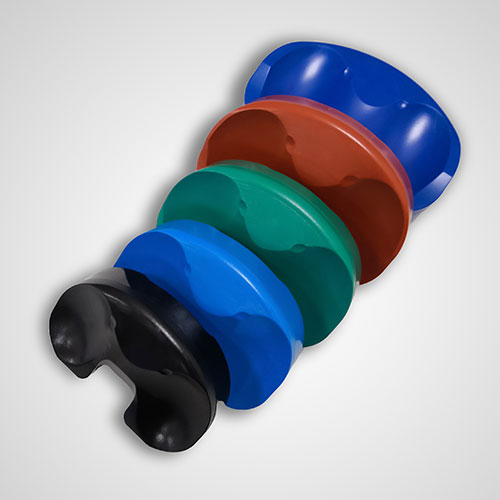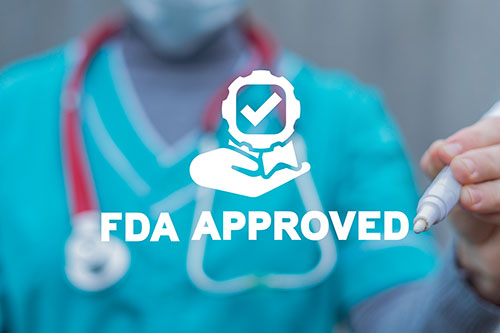Part 2: The 510k Clearance Process
Note: This is Part 2 of a Guide to the FDA Regulatory Processes for Implantable Devices Made from PEEK Polymer and Outlines Requirements for 510k Clearance. A summary of the FDA’s Premarket Approval (PMA) process for implantable devices is available as Part 1, elsewhere on this site. Both guides are intended as general summaries only. Device manufacturers must follow the FDA processes and steps required for each specific device in detail.
Because of their critical nature, implantable medical devices must pass rigorous FDA regulatory approval processes that can require well over a year to complete. For OEMs planning to bring new implantable devices to commercial reality, knowledge of the FDA’s approval and clearance processes and to which classes of devices they apply can prevent significant and costly delays. What’s more, when the device is made from implantable PEEK, working with a well-qualified PEEK resin supplier and a medical polymer conversion expert can help improve the efficiency and effectiveness of the work required to launch the new device.
Implantable Devices Require Either Premarket Approval (PMA) or 510k Clearance, Including PEEK Devices
The FDA categorizes implantable medical devices typically as Class II or III. Unlike devices designated as Class I, those in Class II and III support or sustain essential life functions. Failures of these devices can involve a higher risk of injury or illness. The FDA requires Class II and III devices including those made from implantable PEEK polymers to pass through a 510k clearance process or to satisfy requirements for pre-market approval (PMA) before they can be introduced into the market.
When assessing a device’s classification, the FDA considers several factors. They include:
- The conditions the device is designed to treat
- How and where the device is implanted
- Specific device characteristics, like whether it’s powered or not
- The duration of implantation and whether the implant is resorbed or permanent
Which regulatory path – PMA or 510k – will a specific device made from PEEK polymer need to complete? It depends. If the device’s risks can be identified and accounted for, then it may be considered a Class II device that can be cleared via the 510k process. It’s a case-by-case decision that relies on a predicate device to determine which devices are likely to produce unknown risks.
For many implantable devices, the above risks are well-known and either do not warrant the additional scrutiny of a PMA, or can be mitigated. These devices are likely to be considered Class II and can be cleared via the 510k process. For example, there are numerous orthopedic implants, such as fixation rods, that can be proven safe with performance and efficacy data. This can be attained without the lengthy clinical studies demanded by PMA.
If the above risks cannot be fully understood without clinical data, the implantable PEEK device in question would likely be considered Class III and would need to be approved via the premarket approval process. Artificial heart valves are one example, due to their life-sustaining function, contact with the patient’s blood, and long-term placement.
In summary, implantable PEEK devices eligible for 510k clearance are devices that are generally well-known and understood by regulators.
The Importance of Identifying a Predicate Device

Most devices cleared through 510k are similar to existing devices that have already been cleared or approved by the FDA. Consequently, the initial goal is to identify a predicate device and proving substantial equivalence to the device the OEM plans to introduce. By doing so, the OEM may avoid an expensive PMA submission and bring their device to market through the less costly and less time-consuming 510k channel.
But How Can OEM’s Determine if There is an Appropriate Predicate?
Every medical device is identified using a three-digit product code. This code is associated with an entry in the FDA’s medical device classification database. The FDA has classified more than 1,700 types of medical devices, by their type and by their risk classification (Class I, II and III).
Once an OEM has identified existing devices similar to their own, they can reference those products in the FDA’s database using their codes. If substantial equivalence can be drawn between the OEM’s device and the predicate device, and if the predicate device was cleared through 510k, then the OEM’s device may also be 510k eligible.
The Focus of Most 510k Reviews: Proving Substantial Equivalence
 It’s not enough to identify a potential predicate, though. While the predicate need not be identical to the OEM’s product, there must be provable equivalences between them. For the purposes of demonstrating substantial equivalence, the FDA asserts the following:
It’s not enough to identify a potential predicate, though. While the predicate need not be identical to the OEM’s product, there must be provable equivalences between them. For the purposes of demonstrating substantial equivalence, the FDA asserts the following:
- The device must have the same use as the predicate.
- The device must have the same technological traits as the predicate.
- All submitted information must demonstrate that the device is as safe and effective as the predicate.
If there are notable technological differences, the FDA will review the new device’s performance data to verify that the predicate is appropriate. This review may include an analysis of the device’s engineering performance, biocompatibility data, electromagnetic data, and sterility data. The OEM’s validation processes may also be reviewed to establish substantial equivalence.
If the FDA agrees that there is substantive equivalence between the OEM’s device and the predicate, it can usually pass through the same regulatory channel. This is 510k clearance in most cases.
Notable Differences Between PMA and 510k Submissions
If the device is eligible for 510k clearance instead of premarket approval, it’s usually the preferable choice for OEMs. Here’s why:
- PMAs take longer to prepare and resolve – PMA submissions are far more in-depth than 510k submissions. The FDA will likely require clinical data with human subjects before it will approve one, and clinical trials take time to organize. Further, OEMs can expect to wait up to six months (or longer) before the FDA responds with its decision.
- PMAs are more expensive to prepare and submit – Design, engineering, administrative and FDA-related costs are much greater for PMA submissions. According to the most recent FDA data, it costs almost $100 million to get a device approved, and “only” $30 million to clear one.
There is a benefit to the PMA pathway, though. Devices that pass through their PMA are officially “approved” by the FDA, and not just “cleared.” The manufacturer may assert this in the device’s packaging and labeling. It’s an effective way to communicate the device’s safety to medical professionals and patients.
Traditional, Special or Abbreviated? Determining Which 510k Process is Appropriate for the Medical Device
The 510k clearance process is subdivided into three categories – Traditional, Special and Abbreviated. All medical devices that attain FDA clearance will need to pass through one of these three channels. Which medical devices go through which 510k approval channels? Here’s how to know:
- Traditional – If the device is new and hasn’t been cleared before, a Traditional 510k application is required. A Traditional 510k application is also required when OEMs make significant changes to their device that alter the device’s performance characteristics.
- Special – If significant changes have been made to the device, but those changes do not alter its performance, then a Special 510k application is required. In general, if additional verification and validation are not necessary following the changes – think labeling updates – then a Special 510k application is sufficient.
- Abbreviated – The Abbreviated 510k clearance channel is the proper choice for OEMs that will not use a predicate device as comparison. Instead, an Abbreviated 510k submission typically compares the device to established special controls, an FDA standard, an FDA guidance document, or consensus standard to demonstrate safety and effectiveness.
Here’s How to Prepare for 510k Clearance
The 510k process is lengthy, and successful clearance relies on strong preparation. Here’s what OEMs can expect:
- Verify that the device is properly classified – Before moving forward with a 510k submission, verify the device’s classification by checking the FDA’s Product Classification database. Double check that similar devices have also been cleared through 510k.
- Choose an appropriate predicate or standard to establish substantial equivalence Once the device is classified, identify the closest product comparisons available to compare the device against. These will be the predicates the FDA uses to establish substantive equivalence.
- Identify necessary data to establish equivalence – Consider the function of the device and the predicate to determine what data will be needed to prove efficacy and safety. Performance, effectiveness, and biocompatibility data are the important points of comparison.
- Gather performance, biocompatibility and clinical data – The above information must be included with a 510k submission. It may be derived from engineering testing, clinical testing, material sheets, drawings, photos, and other sources.
- Check FDA guidance on 510k RTA (Refuse to Accept) policies – 510k applications must adhere to the FDA’s policies on proper 510k formatting. These policies are known as the FDA’s RTA criteria, and they establish what must be included in an application for it to pass through the initial review. The FDA has published these policies so OEMs can verify that their submission won’t be turned back for formatting reasons.
- Submit the application and response to any FDA requests – If the application is submitted and passes through the acceptance review, the lead reviewer will take a close look at all included data during the substantive review.It’s possible, though, that the reviewer will require additional information to reach their decision. If they do, they will communicate with the OEM to attain this information. Responding to the FDA quickly will expedite this part of the process.
If the lead reviewer decides that the device may be cleared, the submission will be checked by their managers and additional reviewers. Once a decision is reached, the OEM should be informed within 90 days from the start of the review process.
An Experienced Polymer Converter Can Help with the Information Needed for 510k Clearance
510k clearance takes months to resolve and OEMs must be detailed when putting together an application. The goal is substantive equivalence, and working with an experienced medical polymer converter can help.
From experience with other MDMs, the polymer conversion specialist may help identify similar devices made from implantable PEEK polymer that have been approved or cleared by the FDA. Well-equipped polymer conversion companies can machine prototypes for the MDM to validate a device’s functional performance during product development. A polymer conversion specialist with the proper laboratory equipment and experience can test the physical properties of the PEEK material from which the device is made. Depending on the configuration, it may be possible to test the physical properties of sample pieces cut from actual devices.
These services and test data can provide relevant performance information that supports the MDM’s submission of the device on its path to 510k clearance.
